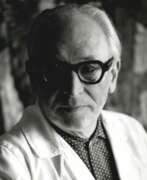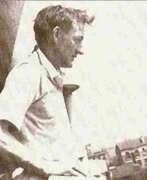Designers Degenerate art
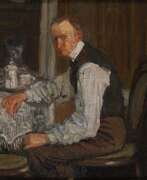

Alexander Gerbig was a German expressionist painter, graphic artist and decorative artist.
Gerbig worked successfully as a decorative painter, studied at the Royal School of Arts and Crafts in Dresden and later at the Royal Academy of Arts in Dresden, traveled Europe on study tours, and won various awards for his paintings.
He served as a soldier during World War I and made numerous sketches of the events he witnessed. In the 1920s Gerbig held several successful exhibitions and actively socialized with almost all art associations of the time. During the years of National Socialist rule in Germany, Gerbig's work was declared degenerate, his paintings were withdrawn from museums and he was forbidden to paint. In 1945, however, he became honorary chairman of the visual arts section of the Zuhl Cultural Association.


Lazar Markovich Lissitzky (Russian: Ла́зарь Ма́ркович Лиси́цкий) was a pivotal figure in the avant-garde art movement of the early 20th century, whose contributions spanned across multiple disciplines including painting, architecture, and graphic design. Born in Pochinok, Russian Empire (now in Smolensk Oblast, Russia), Lissitzky is renowned for his profound influence on the development of Constructivism, a movement characterized by the integration of technology and industry into the arts.
Lissitzky's work is distinguished by its innovative use of geometric forms, bold colors, and dynamic compositions, which sought not only to reflect the modern industrial world but also to actively participate in shaping it. His artworks and theories were instrumental in bridging the gap between the avant-garde movements in Russia and Western Europe, facilitating a cross-cultural exchange that enriched the development of modern art. Among his most notable contributions are his "Proun" series, an acronym for "Project for the Affirmation of the New" in Russian, which encapsulates his vision of art as a transformative social force.
His legacy is preserved in some of the world's most prestigious museums and galleries, including the Museum of Modern Art in New York and the Russian State Museum in Saint Petersburg. These institutions house key works that exemplify Lissitzky's groundbreaking approach to art and design, making them a focal point for collectors and experts in the field of art and antiques.
For those deeply invested in the evolution of modern art and its profound impact on culture and society, Lissitzky's work offers invaluable insights into the creative exploration of form and space. His contributions continue to inspire contemporary artists and designers, emphasizing the enduring relevance of his vision.
We invite collectors and art experts to sign up for updates on new product sales and auction events related to Lazar Markovich Lissitzky. This subscription is an opportunity to stay informed about the latest acquisitions and offerings that celebrate the legacy of a visionary artist whose work continues to resonate with audiences worldwide.
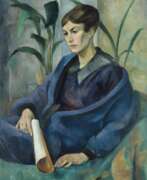

Aleksandra Andreevna Povorina (Russian: Александра Андреевна Поворина), married Ahlers-Hestermann, was a Russian and German modernist painter.
Aleksandra was born in the family of a St. Petersburg civil servant, in 1913 she went to Paris, where she studied at the Russian Academy of M. Vasilieva, joined the circle of artists of the Paris School, became interested in the art of Cézanne and Matisse. In Paris she met the artist from Hamburg Friedrich Ahlers-Hestermann (1883-1973), who became her husband. With the outbreak of World War I, the family moved to Hamburg.
Since 1915 the artist created semi-abstract paintings, participated in group exhibitions at the Commeter Gallery, was a member of the newly created Hamburg Secession with her husband. Under the influence of Paul Cézanne and Henri Matisse, she developed a spiritual-abstract art.
In 1934, the National Socialists who came to power in Germany banned Aleksandra and Friedrich any activity, and abstract paintings Povorina were recognized as degenerate. At that time the artist took up textile design, creating abstract patterns for fabrics, at the same time a series of black and white graphic ink drawings were created. During the war, many of the artist's works were destroyed.
After the end of World War II, Aleksandra took a teaching position at the Weissensee Higher Art School in Berlin, creating abstract collages. After her death, her daughter, textile, mosaic and glass artist Tatjana Ahlers-Hestermann, completed some of her works.
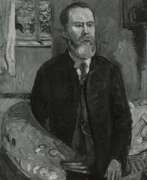

Adolf Schinnerer was a German painter, draughtsman and graphic artist.
He studied at the Art Academy in Karlsruhe and at the Academy of Fine Arts in Munich, and in 1920 took a position as professor of art at the Kunstgewererbeschule in Munich. In Munich, Schinnerer also became one of the founders of the New Secession in 1913. Initially in his works Schinnerer proceeded from the style of French Impressionism, creating mainly figurative paintings and landscapes, later moving to an expressive style of depiction. In the early twentieth century, his prints and paintings were widely exhibited in Italy, France, Austria and Germany.
As a master of dry etching, Schinnerer was an extremely prolific artist, producing hundreds of images and prints; he also executed many illustrations, among them the 1921 edition of William Shakespeare's The Tempest.
In 1937, Schinnerer's graphics were withdrawn from a number of museums and public collections as part of the Nazi "Degenerate Art" campaign. Nevertheless, after the war, the artist regained his reputation: Adolf Schinnerer was a member of the German Artists' Association, participated in the re-establishment of the Union of Original Prints, and the Friends of the Munich State Graphic Collection.


Oskar Schlemmer was a German artist, painter, sculptor, choreographer and designer, and was associated with the Bauhaus movement.
Schlemmer studied at the Kunstgewerbeschule in Stuttgart before becoming a student at the Bauhaus in Weimar in 1920. He taught at the Bauhaus from 1923 to 1929, and was the director of the theater workshop from 1924 to 1929. During this time, he developed a unique style that combined elements of sculpture, painting, and dance.
Schlemmer's work often explored the relationship between the human body and space, and he created a number of abstract figures and costumes for dance performances. He also created a series of sculptures and paintings that explored the idea of the "human condition" and the role of technology in society.
Schlemmer's work was considered controversial by the Nazis, who saw it as "degenerate art." He was forced to leave the Bauhaus in 1929, and his work was removed from public collections in Germany. Despite this, his work continued to be exhibited in Europe and the United States, and he is now considered one of the most important artists of the 20th century.


